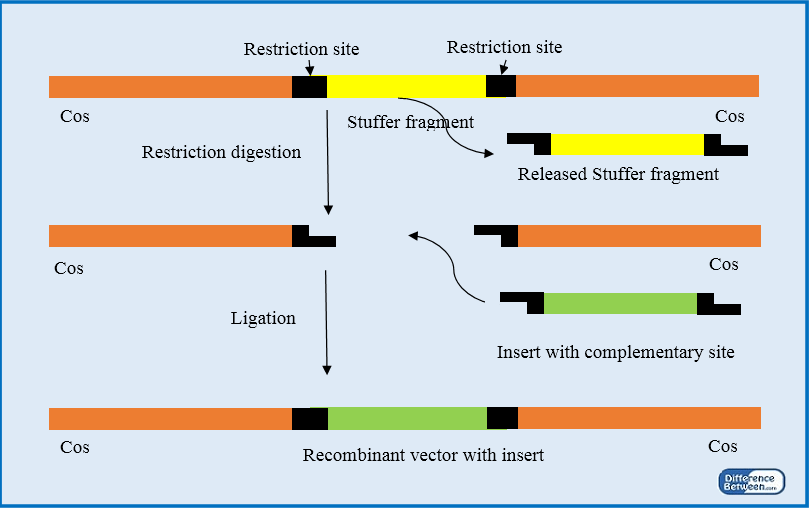Difference Between Insertion and Replacement Vectors
Table of Contents
The key difference between insertion and replacement vectors is that the insertion vector has the ability to insert moderate lengths of foreign DNA while replacement vector has the ability to accommodate larger lengths of foreign DNA.
Phage vectors are the bacteriophages used for cloning. There are two types of phage vectors; they are insertion vector and replacement vector. Also, all phage vectors consist of non-essential genes. However, these genes have to be removed from phages to facilitate new foreign DNA inserts.

CONTENTS
1. Overview and Key Difference
2. What are Insertion Vectors
3. What are Replacement Vectors
4. Similarities Between Insertion and Replacement Vectors
5. Side by Side Comparison – Insertion vs Replacement Vectors in Tabular Form
6. Summary
What is an Insertion Vector?
First of all, insertion vector is the simplest form of lambda cloning vectors. In fact, it is a type of phage vector that has a unique restriction site introduced within the vector genome at the position of optional DNA. Furthermore, the phage DNA remains without a removal. This non-removal of the phage DNA curtails the size of the inserts (foreign DNA) to be cloned within the vector. Moreover, these vectors are useful in cDNA cloning and expression. GT10, GT11, and Zap are examples of this vector.

Figure 01: Lambda Phage
Insertion vector consists of a single recognition site. The primary function of this vector is to develop cDNA libraries derived from eukaryotic mRNA sequences. Moreover, it can only accommodate lengths of foreign DNA ranging in between 05-11 kb. Also, it possesses a unique cleavage site for the insertion of foreign DNA.
What are Replacement Vectors?
Replacement vector or substitution vector is a type of phage vector developed from the removal of a middle ‘filler fragment’ region of phage DNA. The desired foreign DNA insert replaces the phage DNA.

Figure 02: Replacement Vector
Replacement vectors are important in creating genomic libraries such as EMBL4 and Charon40. These vectors can accommodate a larger length of foreign DNA ranging between 08-24kb lengths. The filler region also consists of a gene that makes the phage vector non-viable inside a bacterial host.
What are the Similarities Between Insertion and Replacement Vectors?
- Insertion and replacement vectors are phage vectors.
- Both vectors accommodate foreign DNA inserts.
- They both are helpful in creating DNA libraries.
What is the Difference Between Insertion and Replacement Vectors?
Insertion vs Replacement Vectors | |
| Insertion vector is a type of phage vector that has a restriction site introduced within the phage genome at the site of optional DNA. | Replacement vector is a type of phage vector developed from the removal of a middle ‘filler fragment’ region of phage DNA |
| Size of Insert Fragments | |
| 05-11 kb length | 08-24 kb length |
| Filler Fragment | |
| No filler fragment | Filler fragment gets replaced by a foreign insert |
| Function | |
| Important to create cDNA libraries | Important in creating genome libraries |
| Examples | |
| GT10, GT11, and Zap are examples | EMBL4 and Charon40 are examples |
| Cleavage Site | |
| A unique cleavage site is present | Cleavage site contains genes that are not essential for the lytic cycle |
Summary – Insertion vs Replacement Vectors
Both insertion and replacement vectors are two types of phage vectors. Both vectors have restriction sites which facilitate the accommodation of new foreign DNA inserts. Insertion vectors are important in creating cDNA libraries while replacement vectors are important in creating genomic libraries. Furthermore, insertion vectors accommodate DNA inserts with a moderate length. But replacement vectors can accommodate higher lengths of foreign DNA inserts. In overall, this the key difference between insertion and replacement vectors.
Reference:
1. Hasty, P, et al. “Efficiency of Insertion versus Replacement Vector Targeting Varies at Different Chromosomal Loci.” Molecular and Cellular Biology, U.S. National Library of Medicine, Dec. 1994, Available here.
2. “Lambda Insertion Vectors.” Biology 335 Lecture Notes – Lambda Vectors, Available here.
3. “Replacement Vector.” Replacement Vector – Terminology of Molecular Biology for Replacement Vector – GenScript, Available here.
Image Courtesy:
1. “Lambda phage” By Lizanne Koch – own work with ChemBioDraw (Public Domain) via Commons Wikimedia
ncG1vNJzZmivp6x7pbXFn5yrnZ6YsqOx07CcnqZemLyue8OinZ%2Bdopq7pLGMm5ytr5Wau261zaycq6yZpLturc2dZKudoKGupLHMnqWtZaaasLW70axm